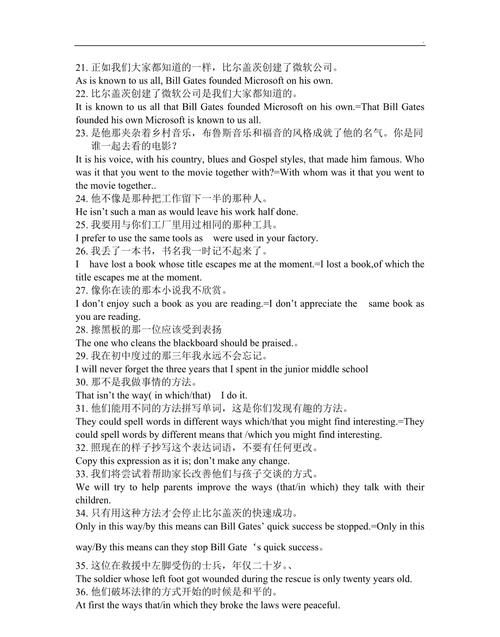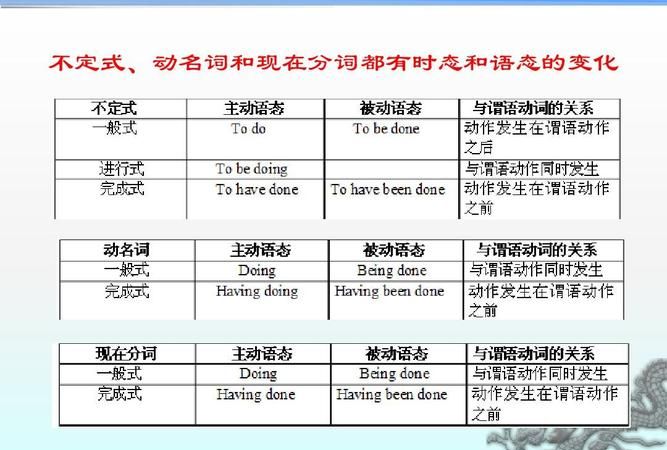本文目录
动名词做定语是什么词性
动名词做定语举例是:
1.动名词作定语,说明被修饰词的性质、特征或用途。如:
He may be in the reading room.
他可能在阅览室里。
They set up an operating table.
他们搭起一个手术台。

2.动名词作定语,表示其与被修饰词之间为主动关系,并且表示动作正在进行。如:
There are about 200 students studying in this school.
大约有200个学生在这个学校学习。
Who is the woman talking to our English teacher?
正在和我们英语老师谈话的那个女人是谁?
3.有些动名词已经转化成了形容词,常用作定语修饰物,表示“令人……”
That must be a terrifying experience.
那肯定是一次可怕的经历。
The experiment was an amazing success.
那实验是一个惊人的成功。
动名词能做定语麻烦举例说明吗
可以.动名词作定语和现在分词作定语的区别如下:
动名词作定语是说明所修饰的名词的用途,
如:a reading room, a swimming pool, a waiting room, a sleeping car等.
现在分词作定语是说明所修饰的名词的动作或性质.
如: a flying kite.a running horse, a moving story 等.

动名词做定语造句英语
1. She came up with a new idea for increasing sales. 她想出了增加销售量的好主意!
2.It is ill to waken sleeping dogs. 别惹麻烦!
3.Police are combing the woods for the missing children. 为了寻找失踪的孩子,警察搜索了整个山林!

动名词的词语
一、作主语
Reading is an art. 读书是一种艺术. Climbing mountains is really fun. 爬山真是有趣. Working in these conditions is not a pleasure but a suffer. 在这种工作条件下工作不是一件愉快的事而是一件痛苦的事. 动名词作主语,在动词的基础上加Ing,使该动词或动词短语,有名词的各种特征,可作名词灵活使用.如: It is no use/no good crying over spilt milk. 覆水难收 It is a waste of time persuading such a person to join us. 劝说这样的人加入真是浪费时间. It was hard getting on the crowded street car. 上这种拥挤的车真难. It is fun playing with children. 和孩子们一起玩真好. There is no joking about such matters. 对这种事情不是开玩笑. 动名词作主语的几种类型 动名词可以在句子中充当名词所能充当的多种句子成分.在这里仅就动名词在句子中作主语的情况进行讨论. 动名词作主语有如下几种常见情况: 1. 直接位于句首做主语.例如: Swimming is a good sport in summer. 2. 用 it 作形式主语,把动名词(真实主语)置于句尾作后置主语. 动名词做主语时,不太常用 it 作先行主语,多见于某些形容词及名词之后.例如: It is no use telling him not to worry. 常见的能用于这种结构的形容词还有:better,wonderful,enjoyable,interesting,foolish,difficult,useless,senseless,worthwhile,等. 注意:important,essential,necessary 等形容词不能用于上述结构. 3. 用于“There be”结构中.例如: There is no saying when he'll come.很难说他何时回来. 4. 用于布告形式的省略结构中.例如: No smoking ( =No smoking is allowed (here) ). (禁止吸烟) No parking. (禁止停车) 5. 动名词的复合结构作主语 当动名词有自己的逻辑主语时,常可以在前面加上一个名词或代词的所有格,构成动名词的复合结构(——这时,名词或代词的所有格做动名词的逻辑主语).动名词的复合结构也可以在句中作主语.例如: Their coming to help was a great encouragement to us. 6.例词 shopping fishing cycling这些都是很常见的动名词 动名词作主语与动词不定式作主语的比较 动词不定式和动名词都可以用作主语.在意义上相近.但动名词多用来表示泛指或抽象动作,不定式多用来表示特指或具体动作.比较: Smoking is not good for health. It is not good for you to smoke so much. 注意: 1) 在口语中,用动名词作主语位于句首的较不定式多见. 2) 在“It is no use...”,“It is no good...”,“It is fun...”,“It is a waste of time...”等句型中,通常用动名词作真实主语: It is no use/good/a waste of time talking about that. *It is no use/good/a waste of time to talk about that. 3) 在疑问句中,通常用动名词的复合结构,而不用不定式的复合结构作主语: Does your saying that mean anything to him? *Does for you to say that mean anything to him? 4) 在“There be”句型中,只能用动名词,而不能用不定式作主语: There is no telling what will happen. It is impossible to tell what will happen. 5) 当句子中的主语和表语都是非限定动词时,要遵循前后一致的原则,主语和表语在形式上要求统一: Seeing is believing. *To see is to believe.
二、作宾语
1.作动词的宾语 某些动词后出现非限定性动词时只能用动名词作宾语,不能用不定式.常见的此类动词有:admit,appreciate,excuse,stand,advise,allow,permit,avoid,consider,enjoy,finish,give up,cannot help,imagine,include,keep,understand,keep on,mind,report,risk,miss,put off,delay,practise,resist,suggest,depend on,think about,set about,succeed in,worry about,burst out,insist on,can't help,feel like,be used to,get used to,devote…to…,look forward to,pay attention to,get down to,escape 等.如: They went on walking and never stopped talking. 他们继续走,说个不停. I found it pleasant walking along the seashore. 在海滩上走真是乐事. Mark often attempts to escape being fined whenever he breaks traffic regulations. 每当马克违反交通规则时,他常常企图逃避罚款的处分. 有些动名词之后既可接动词不定式,又可接动名词,可把这类动词分为三种类型:两种形式所表达的含义基本相同,可以互换.这类动词有: attempt ,begin,cease,continue,intend,omit,start,cannot bear,decline,disdain,loathe,neglect,commence.例如: They ceased talking/to talk. 他们停止说话. Prices will continue to rise/rising. 物价将继续上扬. What do you intend to do/doing next? 你下一步打算干什么? 宾语用不定式和动名词所表达的含义略有变化.用不定式作宾语时,表示特定的一次性的未来动作;用动名词则表示一般的行为,或者是目前正在进行的行为.也可以说,动名词表示泛指的动作,而不定式表示特指的动作.常这样用的动词有: hate,like,love,prefer,dread等.例如: Woula you like to go with me? 你想跟我一起走吗? He preferred to do this rather than do that. 他宁愿做这件事,而不愿做那件事. 2.作介词的宾语 动词+介词+动名词 例如:The rain prevented us from completing the work. 下雨妨碍我们完成工作. She complains of the book being too difficult. 她抱怨这本书太难. 形容词+介词+动名词 例如:I know who is responsible for breaking the window. 我知道窗户是谁打开的. 名词+介词+动名词 例如:There are many ways of doing it. 有许多方法可以做这件事. We are thinking of making a new plan for the next term. 我们正考虑为下学期制定新的计划. Shall we have a rest or get down to doing our work? 我们休息呢还是开始干活? 3.作形容词的宾语 The music is well worth listening to more than once. 这种曲子很值得多听几遍. We are busy preparing for the coming sports meet. 我们正为马上到来的运动会忙着做准备.
三、作表语
动名词作表语时句子主语常是表示无生命的事物的名词或what引导的名词性从句.表语动名词与主语通常是对等的关系,表示主语的内容,主语、表语可互换位置. Your task is cleaning the windows. 你的任务就是擦窗户.(Cleaning the windows is your task.) What I hate most is being laughed at. 我最痛恨的就是被别人嘲笑.(Being laughed at is what I hate most.)
四、作定语
动名词作定语往往表示被修饰词的某种用途.如: a walking stick =a stick for walking=a stick which is used for walking a washing machine=a machine for washing=a machine which is used for washing a reading room=a room for reading=a room which is used for reading a measuring tape=a tape for measuring=a tape which is used for measuring sleeping pills=pills for sleeping=pills which is used for sleeping

以上就是关于动名词作定语例句20个带翻译 ,动名词做定语是什么词性的全部内容,以及动名词作定语例句20个带翻译 的相关内容,希望能够帮到您。
